Warsaw Pact troops
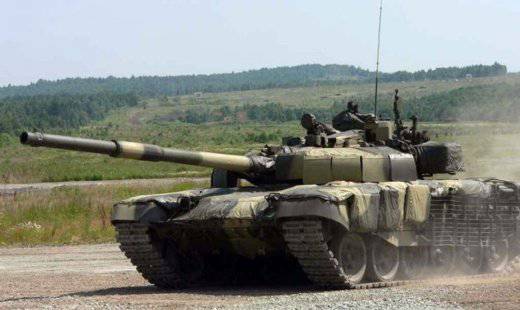
For over 30 years of the Cold War, huge tank the armies of NATO and the Warsaw Pact countries were ready to turn Europe into a kind of battlefield near Prokhorovka, only on an unimaginably large scale. Fortunately nuclear weapons kept the parties from unleashing a bloody massacre. Although story and does not tolerate the subjunctive mood, many people often ask themselves questions “what would have happened. if ..?"
Warsaw Pact troops
The tank fleet of the armies of the Warsaw Pact was huge. It is estimated that he counted 53000 Soviet tanks and about another 12000-15000 Eastern European tanks. However, not all of these machines were planned to be used in a possible military conflict. Most of the old machines were T-54A and T-55, which were located in second-tier divisions stationed in the central part of the USSR. In the event of the start of hostilities, they could be transferred to the west, but they could not participate in the first battles. In addition, a significant grouping of Soviet troops was stationed in the Chinese border, but the equipment of the Far Eastern units was not much better than the units in Central Russia.
The troops of the Warsaw Pact countries represented a rather motley picture. In general, they were divided into the "northern group": GDR, Poland, Czechoslovakia. - and the "southern group": NRB, Hungary and the RAF. The armies of the countries of the northern group were better equipped and, by virtue of the geographic location of the countries, were called upon to play a prominent role in the alleged conflict. Romania was a dubious ally, and weak Bulgaria could not offer any substantial help. Much attention was paid to equipping the armies of Eastern European countries. NATO intelligence agencies have made desperate attempts to determine the equipment of the Polish, German and Czechoslovak divisions, however, the results were minimal. The Soviet command took into account the experience of the Great Patriotic War, when the Polish Army was fully equipped with Soviet weapons. Therefore, the Soviet command was interested not only in the equipment of the Allied armies, but in their combat readiness.
Soviet tanks can be divided into three generations. The first-generation vehicles, T-54A and T-55, accounted for 38% Soviet Army fleet and 85% Allied Army fleet. Every decade, a program was carried out to redesign old tanks, which received new laser range finders, improved fire control systems, as well as additional armored screens. Converted old tanks almost never met in the Soviet divisions of the Western Group of Forces, but there were plenty of them, for example, on the border with Turkey. Second generation tanks - T-62 - accounted for about 24% of the Soviet Army tank fleet. In the armies of other Warsaw Pact countries these machines were practically absent. The T-62 tank was not a cardinally new car, it was an improved T-55, armed with a more powerful gun.
The first tank of the third generation was the T-64 tank, which accounted for about 18% of the total fleet of the Soviet Army. According to its characteristics, the T-64 was at the level of the modern Western tanks M-60, Leopard 1 and Chieftain, but somewhat inferior to them in the power of the gun. The release of the T-64 was stopped at the beginning of the 80-s. In a possible war between NATO and the Warsaw Pact, Soviet T-64 tanks would be the most common. The tank T-72 was a simplified and cheaper version of the T-64, while maintaining the combat characteristics of its predecessor. The T-72 was the first tank of a new generation supplied by the Soviet Union to the allied armies. In addition, the license issue of the T-72 was established in Poland and Czechoslovakia. T-72 tanks accounted for Kolo 16% of the number of Soviet tank forces and about 5-10% of the number of Eastern European armies. The last new tank that appeared before the collapse of the Warsaw Pact was the T-80. It was a further development of the T-64 and T-72 lines, however, it is difficult to compare it with modern Western tanks M1 Abrams, Leopard 2 or Challenger. T-80 tanks accounted for less than 10% of the Soviet fleet and were concentrated mainly in units deployed in East Germany.
The Soviet tank forces were so numerous that old machines had to be used to equip them. In order to completely re-equip the Soviet Army with new tanks it would take at least 20 years. Of course, the old tanks were periodically upgraded, although this did not solve all the problems. Soviet tanks had high speed, good body armor and powerful weapons, not inferior to Western models in these parameters. But the design of the Soviet tanks clearly showed the desire to create a high-tech and cheap car, suitable for mass production. Therefore, on an individual level, Soviet tanks were inferior to American ones, which was more than offset by numerical superiority.
Group of Soviet troops in the GDR
The main shock grouping of Soviet troops in Eastern Europe was a group stationed in the territory of the GDR. The group was better equipped than any other union. In peacetime, it consisted of 8 mechanized and 11 tank divisions, combined in five armies. In addition, each army had a separate tank regiment. In total, the group had 5700 tanks, another 2000 machines were in the first echelon of the reserve, training shelves and other auxiliary units. The staffing of the Soviet tank division numbered about 330 tanks, the staffing of the mechanized division - 220 tanks. The park of the group was constantly updated. The most massive tanks were the T-64A and T-64B vehicles, accounting for about 65% of the fleet. In 1981, the newest T-80 tanks began to arrive, their number eventually reaching 15%. The oldest tank of the Western Group of Forces was the T-62, accounting for about 15% of the park. These machines were mainly in separate tank regiments, training units, etc.
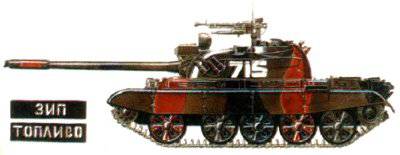
Tank T-XNUMHA (M), Soviet Army, Kiev Military District
At the end of the 80-s in the Soviet Army began to use multi-color camouflage. The Soviet camouflage manuals have always mentioned multicolor camouflage, but in practice it has never been used before. Primary color - olive No. 2. This is a dark green paint, about the color corresponding to the American FS 34077. Initially, parts used and old paint, intended for other purposes. These were black paint No. 2 (intended for painting the running gear of vehicles), black bituminous No. 4 (for painting steel surfaces except the running gear), silver gray No. 1 (for the exterior surfaces of alloy steel parts), brown N ° 2 ( for carbon steel surfaces, including gun barrels), yellow N ° 1 (for steel and aluminum parts of trucks). Special camouflage paints have been used since the mid 80-s. The most commonly used enamel: green ZIL-508M. black CV-714, sand PChV-6, red-brown PCV-26, dark brown PC-113 and white CV-1. Camouflage patterns were traditional. Red-brown (PCV-2) and black (CV-26) spots were applied to the main color (olive N ° 714). Tactical number is done in white paint. Order No. 50 (1982 year) prescribes a tactical number to be applied to the tanks, but the type of the number can be adapted to the type of camouflage. According to the charter, the figures should be 20-40 height cm and 2 / 3 width from height. In the summer, numbers should be applied in white, and in winter, red or black.
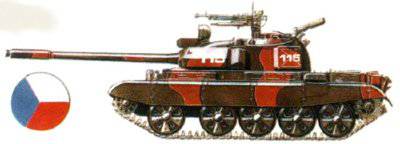
Tank T-55A (M) -Kladivo; Czechoslovak army, 1988 year
The Czechoslovak army used multicolor camouflage for 15 years. For camouflage used short-lived tempera
paint, because camouflage was applied during summer exercises. The most popular colors are ocher and red-brown. There are photos in which it is clear that the border between different colors is highlighted with a black border. The illustration shows a tank, which is a good example of a Warsaw Pact vehicle. The tank is equipped with additional armor, superimposed on both sides of the turret, as well as a Czech-made Kladivo fire control system and a laser rangefinder (all this is located above the gun barrel). An anemometer is mounted at the rear of the tower. On the invoice armor depicted miniature Czechoslovak flags.
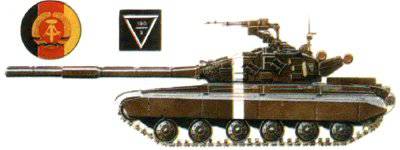
Tank T-64B, Central Group of Soviet Forces, Czechoslovakia, 1988 year
Although the Soviet ground forces used camouflage for tanks, not all vehicles, such as this T-64B, had camouflage. The tank is entirely painted with olive paint No. 2. For the rapid identification of tanks used white stripes, forming a cross when viewed from above. The cross arm of the cross can be seen in the illustration, and the longitudinal line goes along the centerline of the tank through the frontal armor of the hull, along the turret (without touching the barrel) and further along the engine cover. This cross-shaped emblem was often used by the Soviet Army, including in 1940 year Baltic States, in 1945, during the Berlin operation, and in 1968, in Czechoslovakia. Its advantage lies in the fact that it allows you to quickly identify a tank, not only from the ground, but also from the air. In peacetime, the cruciform badge was also used during the exercise to designate a conventional enemy tanks. Traditional geometric signs are visible on the tank. The upper number indicates the regiment, and the lower - the number of the tank. At the end of the 80-ies, a rule appeared requiring the designation of the side boxes and fuel tanks on the T-64, T-72 and T-80 tanks. This is usually the inscription on the pattern of spare parts (tools and instruments) and FUEL. Both labels are illustrated in the inset.
National People's Army of the GDR
The National People’s Army of the GDR (National Volksarmee - NVA) had the closest contact with the Soviet Army. In the event of the outbreak of war, the German divisions would simply be included in the Soviet fronts. This was reflected in the level of equipment of the army of the GDR - NVA was equipped better than any other army of the Warsaw Pact countries.
The NVA consisted of four mechanized divisions and two tank divisions. These parts were located along the Soviet lines. The main tank of the army of the GDR was T-55, accounting for about 80% of the park. The remaining 20% fell on the Slingshot T-72B and T-72G, mainly from Poland or Czechoslovakia. The share of new tanks has steadily increased.
Czechoslovak People's Army
The Czechoslovak People’s Army (CSLA) was also well equipped, primarily thanks to the advanced defense industry of Czechoslovakia. Since Czechoslovakia had a common border with Germany, the Soviet command paid much attention to maintaining the high combat readiness of the Czechoslovak army. Not all Czechoslovak units were fully equipped. This primarily concerned the units stationed in Slovakia. CSLA was the first Eastern European army to upgrade its T-55 tanks. The first step was equipping these tanks with the Kladivo fire control system. Further, the tanks began to equip the invoice armor. The Czechoslovak army consisted of five mechanized and five tank divisions. In total, Czechoslovakia had 2650 tanks, 80% accounted for T-55, and 20% for T-72 slingshot and T-72Г. The CSLA supported the Central Group of Forces of the Soviet Army, consisting of two tank and three mechanized divisions. Soviet troops in Czechoslovakia had 1550 tanks: 20% - T-62, the rest - T-72 or T-64. In the event of war, the CSLA would have to participate in two different operations. Part of the force was to act against the NATO army on the territory of the Federal Republic of Germany, and the other part was to be in reserve in case Austria entered the war.
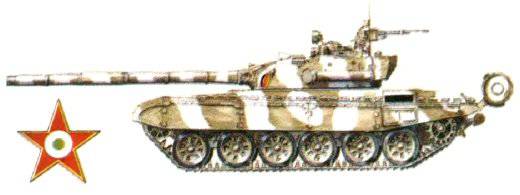
Tank T-72G, 9-I tank division of the GDR, 1987 year
The army of the GDR did not use multi-color camouflage in the summer. Only in winter, stains with white washable paint were applied over the standard dark green color. There were no official standards for winter camouflage, everything depended on the tastes of the crew. Therefore, the camouflage of each tank was individual. The inset shows the signs of nationality of the GDR, Poland, Hungary and Bulgaria.
Polish People's Army
The Polish People's Army (LWP) was the second largest army after the Soviet Army of the Warsaw Pact. But the economic difficulties of Poland adversely affected the technical level of the army. In the event of a possible military conflict, the Polish Army would play only a secondary role. Polish divisions were supposed to be used on secondary sectors of the front: in Austria and Denmark. The Polish army numbered five tank and eight mechanized divisions, as well as several separate tank regiments. In total, Poland had 3100 tanks, of which 300 was T-72b slingshot or T-72G. Only two Soviet tank divisions were stationed on the territory of the PPR, which had 650 tanks, mainly T-62 and T-72.
Tank forces of the rest of the Warsaw Pact member countries
The armies of the three remaining Warsaw Pact member countries, although they had a significant number of tanks, the vast majority of their fleet were old cars. The Hungarian army had 1300 tanks, of which only 100 were T-72, and the rest were T-54A and T-55. Hungary in a possible military conflict was supposed to act against Austria. In Hungary, Soviet 35 and 102-I divisions were stationed under Kechkemet and Szekesfefevarvar, and in the area of Tatabanya and Veszprem - 2-I and 5-I tank divisions. Thus, the grouping of Soviet troops in Hungary exceeded the entire Hungarian army in size and had almost 1400 tanks, of which almost all were T-72 vehicles.
The Romanian army was a self-sufficient formation, and its participation in possible armed conflicts was very problematic. Romania had eight mechanized and two tank divisions, the total number of armored vehicles in the fleet was 1300 tanks, of which almost all were old T-54A (or their Romanian versions TR-580 / TR-77) or TR-800 tanks that are questionable in their combat value.
Bulgaria was farthest removed from the likely theater of operations. Nevertheless, the Bulgarian army consisted of eight mechanized divisions and five tank brigades that had a sufficiently large number of tanks - 1900, of which only 100 were T-72. In the event of war, Bulgaria was to act on the southern flank against Turkey and Greece. There were no any serious forces of the Soviet Army in Bulgaria.
Soviet tank forces in the European part of the USSR
The troops of the Western Military District played the role of the main reserve of forces located in Eastern Europe. Tank and mechanized divisions of the Western IN were in a state of heightened alert. At the same time they were better equipped than the divisions that were in the depths of the Soviet Union. Moreover, the divisions of the Western Military District were even better equipped than the divisions of the Western Group of Forces. The fact. that in the territory of the USSR better secrecy was ensured than in the GDR or Poland.
Warsaw Treaty Forces for War in Europe
As mentioned above, the Warsaw Pact had a huge impact potential, but it was not possible to use all the troops at the same time. The Soviet command carefully concealed its plans, so it is difficult to say exactly where and how it was planned to use tank wedges. The most likely development plan in the event of an armed conflict in Europe was described in 1987 by the American Committee for the Study of Soviet Armies (SASO). The SASO materials state that at the initial stage fighting would be conducted on three fronts, each of which would consist of two to four first-line armies and one fast reserve army. At this stage, 15 tank and 17 mechanized divisions with 9000 tanks would operate in Europe. In the first days, four more tank and five mechanized divisions (3000 tanks) were to arrive. Thus, the first strike force totaled 12000 tanks. Immediately after the start of the war, the Soviet command was to transfer reserves to Europe. Thus, 56% of all Soviet tanks (53350 units), excluding machines located in Central Asia, the Far East and the Leningrad Military District, would take part in the war in Europe. Forces of the first strike included about 12% of the total fleet.
Information